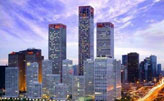Editorials
Energy-efficient buildings
Updated: 2011-05-16 08:03
(China Daily)
A deficiency of electricity in many provinces this year, even before the peak season, shows the urgent need to reduce the power consumption of public buildings to meet the energy-saving targets of the 12th Five-Year Plan (2011-2015).
The Ministry of Finance and Ministry of Housing and Construction jointly released a document prohibiting the construction of power-guzzling buildings and clarifying the State policy of encouraging the renovation of public buildings for more efficient energy use.
The aim is to reduce the power consumption of public buildings by 10 percent per unit area on average by the year 2015, with a 15 percent reduction for the largest buildings.
Statistics show that one-third of public buildings nationwide use glass walls, which, compared to other materials, increase the energy demand for heating in winter and for cooling in summer. On average, power consumption in the country's public buildings is three times that of developed countries.
What is worrying is the fact that 95 percent of new buildings completed in recent years still guzzle more power than required despite the publication of power-consuming standards by the central government in 2005.
Effective measures must be introduced to monitor the construction of new buildings and to oversee the renovation of existing energy-inefficient ones. The former is even more urgent as the construction of energy-inefficient buildings means a waste of money, not just in terms of the greater power consumed, but also the money spent in their renovation for power saving in the future.
According to the newly released document, the central government is to launch projects in some key cities to renovate large public buildings and it will allocate subsidies to support such works. In addition, the government will financially support the building of local monitoring systems to oversee the power consumption of public buildings.
The government also intends to establish a power-saving trading market in the near future. Such trading will make it possible for those public building users who save more than their quota of energy to sell their excess power saving to those whose power consumption is higher than required.
China's development will not be sustainable if its buildings, public buildings in particular, guzzle one-fourth of the total amount of energy the country consumes simply because of poor energy-efficiency design.
To our relief, the central government has realized that administrative measures such as giving orders to local governments are far from enough to meet these power-saving targets. Market options such as the mechanism for trading excess saved energy should stimulate the enthusiasm for users or owners to renovate their buildings or to strengthen management for more efficient use of power. This will be a bright prospect for meeting the nation's energy consumption targets.
(China Daily 05/16/2011 page8)
Specials

The song dynasty
There are MORE THAN 300 types of Chinese operas but two POPULAR varieties are major standouts

Sino-US Dialogue
China and the US hold the third round of the Strategic and Economic Dialogue from May 9-10 in Washington.

Building communities
American architect John Portman and his company have developed more than 30 projects across China.